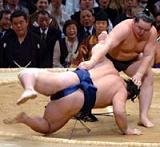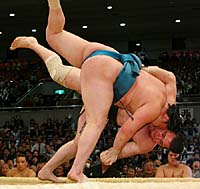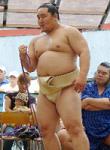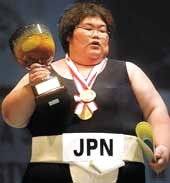 Mike
Wesemann
Mike
Wesemann Mike
Wesemann
Mike
Wesemann
2006 Year in Review
If it seems as though sumo has no momentum right now, it's because it doesn't. After three dramatic basho to kick the year off, the last half of the year has frankly sucked. Now many of you will say that Asashoryu's current dominance is ruining any interest in the sport, but Asashoryu has nothing to do with it. It's the surrounding cast that's to blame. The only time a basho is exciting is when a rikishi or two come forward to legitimately challenge the Yokozuna for the yusho. It happened the first three basho of 2006 making for exciting times until the Yokozuna ran away with the last three basho of the year. You really have to go back to the first half of the year to find any memorable moments...so let's do just that.
Basho of the Year
 This is a tough one because I have to go back 8-11 months, and right now I'm more concerned about battling those little gray hairs that are starting to pop out of my ear lobes instead of focusing on memory retention. But after reviewing the yusho lines, the storylines, and the overall drama of the first three basho, I have to say that the Haru basho was the best this year. Heading into the basho, the three major storylines were Tochiazuma's run at Yokozuna, Hakuho's run at Ozeki, and an under-practiced Asashoryu looking to overcome his first non-yusho in 8 basho. Though these three rikishi would finish the basho with the best three records, Tochiazuma was exposed early--twice
This is a tough one because I have to go back 8-11 months, and right now I'm more concerned about battling those little gray hairs that are starting to pop out of my ear lobes instead of focusing on memory retention. But after reviewing the yusho lines, the storylines, and the overall drama of the first three basho, I have to say that the Haru basho was the best this year. Heading into the basho, the three major storylines were Tochiazuma's run at Yokozuna, Hakuho's run at Ozeki, and an under-practiced Asashoryu looking to overcome his first non-yusho in 8 basho. Though these three rikishi would finish the basho with the best three records, Tochiazuma was exposed early--twice
 in the first week--leaving Asashoryu and Hakuho to fight it out with near flawless performances. The two Mongolians raced out to 10-0 starts before facing each other on day 11 where Hakuho used his size and reach to parlay a hidari-yotsu stalemate into an impressive right outer throw win dropping the
Yokozuna to his first loss. Ozeki-shmozeki...at the end of this bout it was clear that Hakuho was Yokozuna material. Who cared about his promotion to
the sport's second tier? Despite his win over the Yokozuna, Hakuho was stung by his nemesis, Tochiazuma, on day 12, leaving the two Mongolians tied heading into senshuraku at 13-1. After conveniently dropping their bouts against Tochiazuma and Kaio respectively (see
my blog for the how and why) on senshuraku, Asashoryu and Hakuho squared off in a playoff for the yusho producing the best sumo of the year where Asashoryu's experience prevailed handing him his 8th yusho in 9 tournaments. While being forced to settle for promotion to the Ozeki ranks, Hakuho had established himself as the number two guy in the sport.
in the first week--leaving Asashoryu and Hakuho to fight it out with near flawless performances. The two Mongolians raced out to 10-0 starts before facing each other on day 11 where Hakuho used his size and reach to parlay a hidari-yotsu stalemate into an impressive right outer throw win dropping the
Yokozuna to his first loss. Ozeki-shmozeki...at the end of this bout it was clear that Hakuho was Yokozuna material. Who cared about his promotion to
the sport's second tier? Despite his win over the Yokozuna, Hakuho was stung by his nemesis, Tochiazuma, on day 12, leaving the two Mongolians tied heading into senshuraku at 13-1. After conveniently dropping their bouts against Tochiazuma and Kaio respectively (see
my blog for the how and why) on senshuraku, Asashoryu and Hakuho squared off in a playoff for the yusho producing the best sumo of the year where Asashoryu's experience prevailed handing him his 8th yusho in 9 tournaments. While being forced to settle for promotion to the Ozeki ranks, Hakuho had established himself as the number two guy in the sport.
Honorable mention for basho of the year goes to the Natsu basho, where Hakuho, Miyabiyama, and Baruto provided the yusho drama after Asashoryu withdrew early on due to an elbow injury.
Bout of the Year
You could easily argue that the most exciting bout of the year was the Asashoryu - Hakuho matchup in Nagoya, but the yusho was not on the line then, and as we suggested at the time with the help of a Mongolian reader in the know, there was the possibility of some acting going on. So at the risk of sounding like a rerun, the best bout of the year goes to the aforementioned yusho playoff between Asashoryu and Hakuho at the Haru basho. Genghis and Kublai hooked up immediately at the belt from the tachi-ai in the hidari-yotsu position, a stance that favored Hakuho who prefers the left frontal belt grip. Knowing this, Asashoryu timed a perfect maki-kae taking his right arm from the outside of Hakuho's left and latching onto Hakuho belt with an inner grip. Hakuho was forced to grab the left outer which meant that Asashoryu could grab a left outer of his own on the other side, giving the left-handed Yokozuna the uwate advantage. Both rikishi tested the yori-kiri waters to no avail until about 20 seconds in when
Asashoryu perfectly timed a Hakuho charge stepping back a half step, bracing his right thigh against Hakuho's inner left thigh, and catapulting the Sekiwake down with a brilliant inner belt throw. This is what a Yokozuna-taiketsu looks like for those of you who can't remember the last one (Aki 2002).
Honorable mention: Miyabiyama - Baruto day 14 Natsu. Hyping Baruto in early 2006 was justified, but not at the level that everyone (except us of course) had raised it to. In the thick of the yusho race, these two heavyweights hooked up with Miyabiyama easily dismantling Baruto with a straight-forward oshi attack that illustrated just how different the two ends of the Makuuchi division are.
 Rikishi of the Year
Rikishi of the Year
How ridiculous is it that this seemed like a down year for Asashoryu because he only took 4 yusho? The Yokozuna didn't exactly get off to a fast start dropping two of the first three tournaments due to injuries, but he cruised the last half of the year showing that currently the only thing that can defeat him is an injury. Asa finished the year in fifth place all time with 19 yusho, but watch out Takanohana (22 yusho) and Kitanoumi (24) because yous two are in the cross hairs for 2007. There was no way that Asashoryu was going to set any new records this year after his perfect 2005, but he's still the rikishi of the year by a long shot.
Rikishi of the Year besides Asashoryu
Hakuho was the glue that held this sport together this year while Asashoryu was working out his injury problems. The Ozeki enjoyed his breakout year in 2006 posting win totals of 13, 13, 14, and 13 in his first four tournaments picking up one yusho in the process and coming as close to Yokozuna promotion as a foreigner can come. It makes you wonder if things would have been different had he not thrown that bout against Kaio in March. Hakuho was so dominant this year that he still came in second place in overall wins in 2006 (61 vs. Asashoryu's 62) despite just 8 wins over his last two tournaments. Even though Hakuho has lost his momentum heading into 2007, in 2006 he came as close as anyone has to equaling Asashoryu on the dohyo.
Newcomer of the Year
 Of the rikishi who made their Makuuchi debuts in 2006, no one remotely compares to Baruto. Expectations are so high for this Estonian that it seems we're disappointed when he posts just 10 wins. Baruto has instilled the fear of god into two thirds of the division, and he hasn't even broken into the sanyaku yet. Baruto has no equal when it comes to size and strength, so if he can polish up his technique a bit, watch out.
Of the rikishi who made their Makuuchi debuts in 2006, no one remotely compares to Baruto. Expectations are so high for this Estonian that it seems we're disappointed when he posts just 10 wins. Baruto has instilled the fear of god into two thirds of the division, and he hasn't even broken into the sanyaku yet. Baruto has no equal when it comes to size and strength, so if he can polish up his technique a bit, watch out.
Biggest Disappointment
I hate to do it to the guy, and you Bulgarian readers may as well click those "create new email" buttons now, but your man, Kotooshu, was the biggest disappointment in 2006. Let's go back to Nagoya 2005 when Kotooshu narrowly missed his first yusho at 12 wins after crushing Asashoryu on day 8. Kotooshu came oh so close again in September as he posted 12 wins again, and he sealed the Ozeki deal in Kyushu with an 11 win performance that included another defeat of Asashoryu. Heading into 2006, this new Ozeki was going to provide that first chink in Asashoryu's armor. He was going to pick up his first yusho, and he was even going to threaten for the Yokozuna rank...right? Wrong on all counts. I know, I know, Kotooshu was injured in March and that right leg even gave him problems into the Natsu basho and perhaps the Nagoya basho. What about after that? Name one big Kotooshu win for me in 2006 including the Hatsu basho before he was injured. You can't because there were none. No wins against Asashoryu, no wins against Baruto, one win against Hakuho in Aki when Hakuho was a mess and finished 8-7. Kotooshu did fare well against his fellow Ozeki not named Hakuho, but so what? Kotooshu was in the same place at the end of 2005 that Hakuho is in now heading into 2006. Hakuho is on the hot seat for biggest disappointment in 2007, but for 2006, Kotooshu earns the dubious honors.
Most Improved
This is an interesting category for 2006. There could be a few trendy picks like Kotoshogiku or Tokitenku, but when I look at the sport the last two years, there is no question that the most improved rikishi from 2005 to 2006 is the Sheriff himself, Miyabiyama. I know that this dude was a former Ozeki, but back then he rode the coattails of stablemates (1 Yokozuna, 2 Ozeki) to the rank. Now he is earning it all on his own. Last year Miyabiyama compiled 45 wins ranked half the time in the sanyaku and half the time in the rank and file. This year Miyabiyama tallied 59 wins ranked among the jo'i the entire year. He was a legitimate yusho threat in Natsu, and he came as close as one could to regaining the Ozeki rank. I also don't think anyone was henka'd more this year than Miyabiyama. The reason is that rikishi don't want to deal with him. When you look at the top rikishi in 2006, Asashoryu and Hakuho are an easy 1 and 2 pick. But who's number three? Maybe you can give that distinction to Tochiazuma because of his one yusho, but Miyabiyama was more consistent than the Ozeki in my opinion throughout the year. At worst, Miyabiyama was in the top four of the sport in 2006.
Least Improved
This perennial Sekiwake began 2006 ranked at the bottom of the Makuuchi division literally after an injury at the end of 2005. He scored 10 wins in January, 11 wins in March, and then a win on day 2 of the Natsu basho over Asashoryu from the M2 rank. What happened after that was a
train wreck. Wakanosato finished the Natsu basho at 6-9 before a wicked leg swipe from Ama at the Nagoya basho sent him into a freefall to the bottom of the Juryo ranks with a leg injury. Wakanosato managed a 10-5 record from J11 in Kyushu, so hopefully it's a sign that he's back on track, but
injury or not, no rikishi that has played as significant a role as Wakanosato has in the upper Makuuchi division has fallen as far and as fast.
Dishonorable mention goes to former Sekiwake, Tamanoshima, who only managed one kachi-koshi all year ranked at M8.
Biggest Surprise
What year doesn't include a few surprises? There was Kyokushuzan's sudden retirement and the shady allegations that followed. Sumotalk tallied its half millionth hit, which means that we've conned a lot of people for a long time. And I was really surprised that more rikishi besides Chiyotaikai didn't bring home a rash from the Taiwan jungyo. But all that aside, the biggest surprise of 2006 was Miyabiyama's legitimate yusho run at the Natsu basho. From day 1, Miyabiyama's sumo was different. There was an air about the Sheriff that was he was just going to go out every day and kick your ass, which he did for the most part. Only two of his 14 wins were by pulldown techniques, but both of those were set up by powerful, offensive sumo. Miyabiyama ended up losing the yusho to Hakuho in a playoff bout, but his run at the Natsu basho and mid-year tear in the sport was my biggest surprise.
Biggest non-sumo headline that
threatened to interrupt the Makuuchi broadcast
Fortunately, not a single Makuuchi bout's broadcast was interrupted this year by breaking news in Japan although we had a close call on day 6 of the Aki basho when newly-born Prince Hisahito was driven home from the hospital where he was born to the Royal Palace. Since I know ones of you actually follow the Royal Household news, gossip, etc. let's just review the events. Prince Hisahito's birth was the first time that a boy was born to the Royal Family in 41 years. The huge drought really had Japan gripping because their current constitution states that only a male can succeed the throne. Problem was the two boys of the current
Emperor, Heisei, only had three girls among them and their wives were nearing the time when they could no longer have children. This crisis spurned Japan's congress into action and talks were held beginning in 2005 debating a change of the law that would allow a female
successor to the throne. The talks suddenly stopped early this year, however, when it was learned that Princess Kiko, wife of the
Emperor's second son, was pregnant. The Imperial Household never reveals the sex of the expected baby, but it was obvious that a boy was in the womb when Japan's congress suddenly dropped the issue.
So to no one's surprise, a bouncing baby boy was born on September 5th easing the nation's fears after 41 years. I usually catch NHK's news programs daily, and I happened to be watching when the birth was officially announced. NHK sent their street reporters out in droves to capture public reaction. It went something like this:
Reporter: Did you hear that Kiko-sama had her baby?
Interviewee: Eh!? What was it?
Reporter: It was a boy.
Interviewee: Oh, that's great...it was a boy!! Er...uh...I would have been just as happy if it had been a girl...er...uh...the most important thing is that the baby is healthy...er...uh...
You get the point. From the Prime Minister to that woman shopping at the local grocery store wearing her apron and sporting a mole on the side of her nose the size of an acorn to even Yokozuna Asashoryu, the reaction was always the same: "Yes! A boy! (Eh? Otoko-no-ko? Yokatta!!)" followed by blubbering and stammering trying to emphasize that it would have been just as nice if another girl were born. Yeah, right. The coverage surrounding the birth of Prince Hisahito was unprecedented, especially compared to the births of the three existing female grandchildren of the
Emperor.
My whole point in this is to ask the people of Japan would it be too much to treat your women
better and give them equal status in society? If you've ever worked for a Japanese company, this is the usual structure of the bottom two rungs:
Rin-shoku-san (or rinji-shoku-in): This is translated as temporary employee. These are always female workers who are hired for a period of a few months and then released only to be hired later on for a few more months. In between
hirings, the girls live off of unemployment benefits, and the cycle continues over and over. They just bounce around from job to job hoping to find a decent guy to marry. These rin-shoku-san people do a majority of the work in a Japanese office.
OL (office lady): OL's make up the brunt of the female working community. They are permanent employees (until they get pregnant) and do all of the work that the rin-shoku-san's can't finish. Also, many offices don't bother to hire the temporary help, so in these cases, the OL's have to do it all, and of course they are also the ones that have to serve tea and coffee in the mornings and at 3 PM to the male employees even though technically their statuses with the company are the same.
I've worked in plenty of Japanese offices in industries spanning government, banking, and IT, and it's all the same. The females are treated like crap. Is it any wonder that fewer and fewer women in Japan are deciding to marry at all? The trend is alarming, but the women are figuring it out and saying enough is enough. What's one of the most booming industries in Japan among the well to do that hasn't caught on in any other developed nation? The pet industry, especially the ownership of dogs. Females are now turning to mutts because they make better companions than Japanese dudes. Outstanding.
So what does any of this have to do with sumo? Isn't it about time that we give
women full equality in sumo and allow them to step atop the dohyo in Japan?
Uh...no. Forget I even said any of this. Happy New Year everyone. See you next week with my Hatsu pre-basho report.

Home
| 2004 Year in Review
| 2005 Year in Review